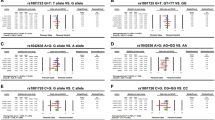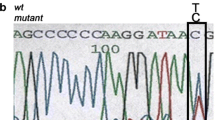Abstract
The calcium-sensing receptor (CaR) polymorphism A986S has been found to be associated with higher serum calcium levels in normal subjects, suggesting that this amino acid change might decrease the inhibitory activity of the mutated receptor, render the parathyroid cells more prone to proliferate, and eventually increase the risk of developing primary hyperparathyroidism (PHPT). The aim of the present study was to investigate the frequency of this and other 2 known CaR polymorphisms (R990G and Q1011E) in patients with PHPT and their effect on its phenotype. We studied 103 Italian patients with PHPT and 148 healthy Italian subjects and we compared the results in 50 pairs matched for sex, age and geographic provenience. A fragment of exon 7 of the CaR gene, containing the 3 polymorphic loci of interest (A986S, R990G, and Q1011E), was amplified by PCR and sequenced. Serum calcium and PTH levels, BMD and other biochemical and clinical parameters were evaluated. The frequency distribution of the A986S, R990G, and Q1011E polymorphisms in the 103 PHPT patients was 39.8%, 5.8%, and 2.0%, respectively. There was no difference in the frequency of the 3 CaR polymorphisms in the 50 matched pairs of patients and controls. We found no significant difference in several clinical and biochemical parameters between PHPT patients carrying or not the 986S allele. Finally, no relationship was observed between the 986S genotype and total and ionized serum calcium in control subjects. The A986S CaR polymorphism is the most common in Italian PHPT patients and the allotype AS does not appear to play a relevant role in the pathogenesis of PHPT and its severity. The A986S polymorphism does not correlate with serum calcium levels in normal Italian subjects.
Similar content being viewed by others
References
Chattopadhyay N., Mithal A., Brown E.M. The calcium sensing receptor: a window into the physiology and pathophysiology of mineral ion metabolism. Endocr. Rev. 1996, 17: 289–307.
Pearce S.H.S., Thakker R.V. The calcium-sensing receptor: insight into extracellular calcium homeostasis in health and disease. J. Endocrinol. 1997, 99: 88–96.
Pollak M., Brown E.M., Estep H.L. et al. Mutations in the human Ca2+-sensing receptor gene cause familial hypocalciuric hypercalcemia and neonatal severe hyperparathyroidism. Cell 1993, 75: 1297–1303.
Pearce S., Trump D., Wooding C. et al. Calcium sensing receptor mutations in familial benign hypercalcemia and neonatal severe hyperparathyroidism. J. Clin. Invest., 1995, 96: 2683–2692.
Heath H. III, Odelberg S., Jackson C.E. et al. Clustered inactivating mutations and benign polymorphisms of the calcium receptor gene in familial benign hypocalciuric hypercalcemia suggest receptor functional domains. J. Clin. Endocrinol. Metab. 1996, 81: 1312–1317.
Pollak M.R., Brown E.M., Estep H.L. et al. Autosomal dominant hypocalcemia caused by a Ca2+-sensing receptor gene mutation. Nat. Genet. 1994, 8: 303–307.
Pearce S., Williamson C., Kifor O., et al. A familial syndrome of hypocalcemia with hypercalciuria due to mutations in the calcium sensing receptor. N. Engl. J. Med. 1996, 335: 1115–1122.
Hosokawa Y, Pollak M.R., Brown E.M., Arnold A. Mutation analysis of the extracellular Ca2+-sensing receptor gene in human parathyroid tumors. J. Clin. Endocrinol. Metab. 1995, 80: 3107–3110.
Cetani F., Pinchera A., Pardi E. et al. No evidence for mutations in the calcium-sensing receptor gene in sporadic parathyroid adenomas. J. Bone Miner. Res. 1999, 14: 878–882.
Chikatsu N., Fukumoto S., Takeuchi Y. et al. Cloning and characterization of two promoters for the human calciumsensing receptor (CaSR) and changes of CaSR expression in parathyroid adenomas. J. Biol. Chem. 2000, 275: 7553–7557.
Kifor O., Moore F.D., Wang P. et al. Reduced immunostaining for the extracellular Ca2+-sensing receptor in primary and uremic secondary hyperparathyroidism. J. Clin. Endocrinol. Metab. 1996, 81: 1598–1606.
Gogusev J., Duchambon P., Hory B. et al. Depressed expression of calcium receptor in parathyroid gland tissue of patients with hyperparathyroidism. Kidney Int. 1997, 51: 328–336.
Farnebo F., Enberg U., Grimelius L. et al. Tumor-specific decreased expression of calcium-sensing receptor messenger ribonucleic acid in sporadic primary hyperparathyroidism. J. Clin. Endocrinol. Metab. 1997, 82: 3481–3486.
Cetani F., Picone A. Cerrai P. et al. Parathyroid expression of calcium-sensing receptor protein and in vivo parathyroid hormone-Ca2+ set-point in patients with primary hyperparathyroidism. J. Clin. Endocrinol. Metab. 2000, 85: 4789–4794.
Rubin L.A., Peltekova V., Janic N. et al. Calcium sensing receptor gene: analysis of polymorphism frequency. Scand. J. Clin. Lab. Invest. 1997, 57: 122–125.
Cole D.E.C., Peltekova V., Rubin L.A. et al. A986S polymorphism of the calcium-sensing receptor and circulating calcium concentration. Lancet 1999, 353: 112–115.
Cole D.E.C., Vieth R., Trang H.M., Womg B.Y.L., Hendy G.N., Rubin L.A. Association between total serum calcium and the A986S polymorphism of the calcium-sensing receptor. Mol. Genet. Metab. 2001, 72: 168–174.
Miedlich S., Lamesch P., Mueller A., Paschke R. Frequency of the calcium-sensing receptor variant A986S in patients with primary hyperparathyroidism. Eur. J. Endocrinol. 2001, 145: 421–427.
Yamauchi M., Sugimoto T., Yamaguchi T. et al. Association of polymorphic alleles of the calcium sensing receptor gene with the clinical severity of primary hyperparathyroidism. Clin. Endocrinol. 2001, 55: 373–379.
Potts J.T. (Ed). NIH Consensus Development Conference Statement on Primary Hyperparathyroidism. J. Bone Miner. Res. 1991, 6: S9–S13.
Marcocci C., Golia F., Bruno-Bossio G., Vignali E., Pinchera A. Carefully monitored levothyroxine therapy is not associated with bone loss in premenopausal women. J. Clin. Endocrinol. Metab. 1994, 78: 818–823.
Sambrook J., Fitsch E.F., Maniatis T. Molecular cloning: A laboratory manual 2nd ed., Cold Spring Harbor laboratory, Cold Spring Harbor, New York, 1989, vol 1, 2, E3–E5.
Bilezikian J.P., Silverberg S.J., Gartenberg F. et al. Clinical presentation of primary hyperparathyroidism. In: Bilezikian J.P., Levine M.A., Marcus R. (Eds.), The Parathyroids. Raven Press, Ltd., New York, 2001, p 457.
Carling T., Kindmark A., Hellman P., et al. Vitamin D receptor genotypes in primary hyperparathyroidism. Nat. Med. 1995, 1: 1309–1311.
Carling T., Rastad J., Akerstrom G., Westin G. Vitamin D receptor (VDR) and parathyroid hormone messenger ribonucleic acid levels correspond to polymorphic VDR alleles in human parathyroid tumors. J. Clin. Endocrinol. Metab. 1998, 83: 2255–2258.
Carling T., Rastad J., Kindmark A., Lundgren E., Ljunghall S., Akerstrom G. Estrogen receptor gene polymorphism in postmenopausal primary hyperparathyrodism. Surgery 1997, 122: 1101–1105.
Khosla S., Ebeling P.R., Firek A.F., Burritt M.M., Kao P.C., Heath III H. Calcium infusion suggests a “set-point” abnormality of parathyroid gland function in familial benign hypercalcemia and more complex disturbances in primary hyperparathyroidism J. Clin. Endocrinol. Metab. 1993, 76: 715–720.
Rao D.S Parathyroidectomy for asymtomatic primary hyperparathyroidism (PHPT): is it worth the risk? J. Endocrinol. Invest. 2001, 24: 131–134.
Rastad J. Parathyroidectomy for asymtomatic primary hyperparathyroidism (PHPT): is it worth the risk? J. Endocrinol. Invest. 2001, 24: 56–61.
Author information
Authors and Affiliations
Corresponding author
Rights and permissions
About this article
Cite this article
Cetani, F., Borsari, S., Vignali, E. et al. Calcium-sensing receptor gene polymorphisms in primary hyperparathyroidism. J Endocrinol Invest 25, 614–619 (2002). https://doi.org/10.1007/BF03345085
Accepted:
Published:
Issue Date:
DOI: https://doi.org/10.1007/BF03345085




